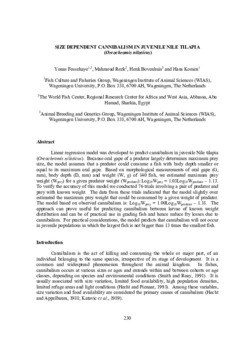Size dependent cannibalism in juvenile Nile tilapia (Oreochromis niloticus)

Citation
Fessehaye Y.; Rezk, M.A.; Bohenvius, K. (2004). Size dependent cannibalism in juvenile Nile tilapia (Oreochromis niloticus). Sixth International Symposium on Tilapia in Aquaculture. Manila, Philippines, 12-16 September 2004 pp. 230-240
Cannibalism among tilapia fry and fingerlings has been identified as one of the major problems by small-scale hatchery operators (Pantastico et at., 1988). Despite the increasing interest in this species, cannibalism among cultured Nile tilapia has received little attention and the factors underlying it have not been investigated in detail. Silvera (1978) studied the reproduction of young tilapia in plastic swimming pools and noted that the rate of cannibalism was proportional to the length of the fingerlings involved. In addition, Smith (1989) suggested that maximum prey size was a function of cannibal gape. In this experiment we will test the hypothesis that prey size in O. nitoticus is a function of predator oral gape and prey body depth (deepest part of the body) and that cannibalism can be predicted based on body measurements of predator and prey.
Permalink
Date Available
Research Themes
Language